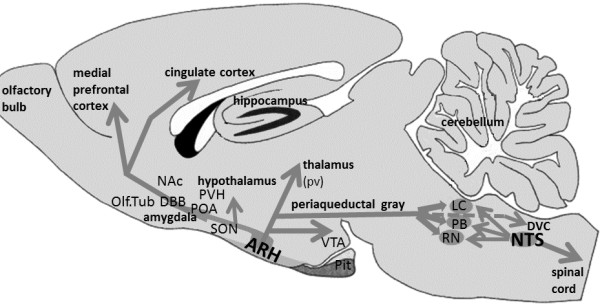Figure 1.
Diagram showing the opiocortin projections from the arcuate nucleus of the hypothalamus. The arcuate nucleus (ARH) contains most β-END cell bodies and is located in the mediobasal hypothalamus, at both sides of the 3rd ventricle (not shown). Extensive opiocortin projections arise from the ARH and extend in rostral, cortical, hypothalamic and caudal brainstem directions. The most caudal projections extend into the dorsal vagal complex (DVC), comprising the area postrema, the dorsal vagal nucleus and the nucleus of the solitary tract (NTS). Limbic regions predominate as target areas for the ARH projections. In the caudal brainstem, in the NTS itself, another group of β-END cells has been detected. Their opiocortin fibers project mainly to brainstem areas as well as down the spinal cord. A number of brainstem areas, involved in numerous autonomic functions, receive a double innervation from both the ARH and the NTS: locus coeruleus (LC), the parabrachial region (PB) and several raphe nuclei (RN). Abbreviations: NAc: nucleus accumbens; Olf. Tub: olfactory tubercle; DBB: diagonal band nuclei; POA: preoptic area; PVH: paraventricular hypothalamic nucleus; SON: supraoptic hypothalamic nucleus; pv: periventricular thalamus; Pit: pituitary; VTA: ventral tegmental area.

